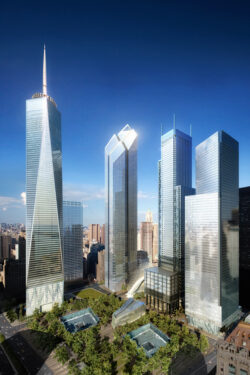PART 2 THE COMMERCIAL IMPERATIVE
Two design competitions determined the direction of the master plan at Ground Zero and the concept and position of the 9/11 memorial and museum. Ultimately the memorial, museum, and landscaped plaza encompassed eight of the sixteen acres of the World Trade Center site. The very public and political process of creating the cultural institutions on that half of the site was the subject of an enlightening discussion on September 21, 2021, with Craig Dykers, Gary Hack, Lynne Sagalyn, and Frank Sciame, Jr. that can be viewed on video.
Meanwhile, on the other eight acres, five skyscrapers that would replace the 10 million sq. ft. of office space in the destroyed World Trade Center moved forward, with the key player being the private investor-developer, Silverstein Properties. While the replacement for the collapsed 7 WTC rose quickly, the other towers stalled. Today, after many revisions in design and repositions of ownership, three of the masterplan buildings are completed, while Tower 2 has stump foundations and an indeterminate future. The problematic site on the southern edge of the memorial plaza for a mixed-use Tower 5 has recently been announced.
Part 2 of our pair of programs on the rebuilding, Ground Zero Master Plans: The Commercial Imperative, assessed the tensions between the private office development and the economic context, the pace of rebuilding, and the constraints of politics on the city, state, and federal levels. Leading the discussion as a speaker and moderator was LYNNE B. SAGALYN, author of Power at Ground Zero: Politics, Money, and the Remaking of Lower Manhattan (Oxford, 2016).
Our informed panel brought together key players in the development, design, and construction of the commercial component of the rebuilding of the World Trade Center site:
KENNETH LEWIS, a Partner at SOM, managed the architectural teams for both 7 World Trade Center and One World Trade Center.
ROBERT LIEBER, served as Deputy Mayor of Economic Development from 2008 to 2010 and represented the City on the board of the Lower Manhattan Development Corporation.
ROBIN PANOVKA, a partner at the law firm Wachtell Lipton and co-chairman of their Real Estate practice, represented Silverstein Properties in the redevelopment of the World Trade Center for more than a decade.
CHRISTOPHER O. WARD, served as executive director of the Port Authority of New York and New Jersey from 2008 until 2011, overseeing the rebuilding at World Trade Center and other projects.
